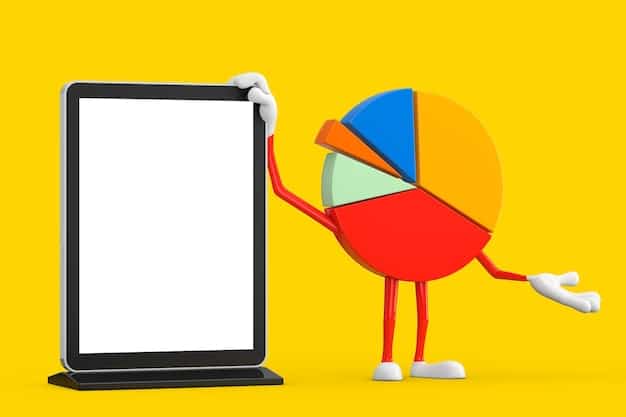The Ultimate Guide to Budgeting: Save 15% More Every Month

The Ultimate Guide to Budgeting provides a comprehensive framework to effectively track your spending, create a personalized budget, identify areas for savings, and ultimately increase your monthly savings by 15% or more.
Ready to take control of your finances and achieve your savings goals? The Ultimate Guide to Budgeting: Track Your Spending and Save 15% More Each Month will provide you with the knowledge and tools you need to create a budget that works for you, allowing you to gain financial freedom and save more effectively.
Why Budgeting is Essential for Financial Success
Budgeting isn’t just about restricting spending; it’s about making informed decisions about your money. It provides a clear picture of where your money is going and empowers you to make adjustments to align your spending with your financial goals.
A well-structured budget allows you to prioritize spending, identify areas where you can cut back, and allocate funds towards savings and investments. This proactive approach helps prevent overspending and ensures you’re on track to achieve your long-term financial objectives.
Understanding Your Financial Landscape
Before creating a budget, it’s crucial to understand your current financial situation. This involves assessing your income, expenses, assets, and liabilities. A clear understanding of your financial standing will provide a solid foundation for building a successful budget.
Gather all your financial documents, including bank statements, credit card bills, loan statements, and investment reports. Analyze your income sources and identify all your expenses, both fixed and variable. This comprehensive overview will help you identify areas for improvement and create a realistic budget.
- 🔍 Categorize your expenses to identify spending patterns.
- 📊 Track your net worth to measure your financial progress.
- 🎯 Set realistic financial goals based on your current situation.
Effective budgeting is a powerful tool for achieving financial stability and reaching your financial aspirations. By understanding the principles of budgeting and implementing practical strategies, you can transform your relationship with money and pave the way for a brighter financial future.

Step-by-Step Guide to Creating a Budget That Works
Creating a budget that works for you involves a systematic approach. This detailed guide includes several stages, each designed to help you create and maintain a financial plan to achieve your 15% savings goal.
We’ll cover everything from calculating your income and spending, making informed budgeting choices, and setting up alerts and reminders to stay on track with your budget.
Calculate Your Income
The first step is to determine your monthly income. If you have a regular salary, this is straightforward. If you have variable income, calculate an average based on the past few months. Be sure to use your net income (after taxes and other deductions) for budgeting purposes.
Include all sources of income, such as salary, freelance work, investments, or any other regular payments you receive. This comprehensive view will provide an accurate picture of the money you have available for budgeting.
Track Your Spending
Tracking your spending is essential for understanding where your money is going. Use a budgeting app, spreadsheet, or notebook to record every expense. Categorize your spending to identify areas where you might be overspending.
Start by identifying patterns. Do you often eat out? Are there subscriptions you don’t use anymore? Once you know where the money is going, you can make informed decisions about cuts.
- 💰 Use budgeting apps like Mint or YNAB for automated tracking.
- ✍️ Keep a spending journal to manually record your expenses.
- 🧾 Review bank and credit card statements regularly.
By following these steps and consistently tracking your income and expenses, you can create a budget that works efficiently and achieve your financial goals with more confidence.
Strategies for Tracking Your Spending Effectively
Tracking your spending can be a daunting task if done manually. However, many strategies and tools make it easier and more efficient. Choosing the right strategy will help you align your spending habits with your financial goals.
We’ll explore several methods, from traditional techniques to modern technological solutions to help you track your spending and optimize your money managemen
Budgeting Apps and Software
Budgeting apps like Mint, YNAB (You Need A Budget), and Personal Capital offer automated spending tracking, budget creation, and goal setting. These apps connect to your bank accounts and credit cards, automatically categorizing your transactions.
These apps offer real-time insights into your spending habits, making it easier to identify areas where you can reduce expenses. They also provide customizable alerts and notifications to help you stay on track with your budget.
Spreadsheet Budgeting
Creating a spreadsheet budget provides flexibility and customization. You can create your own categories, formulas, and visualizations. Use tools like Google Sheets or Microsoft Excel to track your income, expenses, and savings.
Set up categories for your income and expenses. Use formulas to automatically calculate totals and track your progress. You can also create charts and graphs to visualize your spending patterns and identify areas where you can save more.
- 📊 Customize your spreadsheet to fit your specific needs.
- ✏️ Use formulas to automate calculations.
- 📈 Create charts to visualize your spending habits.
By embracing these techniques and consistently monitoring your spending, you transform your financial habits and pave the way to achieve sustainable savings and financial wellness.

Identifying Areas to Reduce Spending and Increase Savings
Once your income and expenses have been well-documented, identifying areas to reduce spending is crucial. This can be achieved by analyzing your current spending, prioritizing needs over wants, and making conscious decisions to cut unnecessary costs.
Examining your existing accounts and subscriptions is invaluable in prioritizing your needs and aligning your spending more closely.
Prioritize Needs vs. Wants
Distinguish between essential needs (housing, food, transportation) and non-essential wants (dining out, entertainment, luxury items). Focus on reducing spending on wants while maintaining your needs. This mindset shift will free up more money for savings and financial goals.
Needs are those expenses required to maintain a certain standard of living. Wants, while enjoyable, are not essential for survival or well-being. By consciously differentiating between the two, you can prioritize spending on what truly matters.
Cut Unnecessary Expenses
Review your recurring expenses, such as subscriptions, memberships, and services. Cancel or downgrade those that you don’t use or need. Identify small, everyday expenses that add up over time, such as daily coffee or snacks, and find ways to reduce them.
Examine your monthly expenses: can you cut a subscription? Can you lower your internet? Every $20 counts.
- ☕ Reduce daily coffee or snack expenses.
- 🍽️ Prepare meals at home instead of eating out.
- 🛒 Shop around for better deals on insurance and utilities.
By actively identifying areas to cut costs, you’ll boost your savings rate and ensure more of your income goes towards building a strong financial foundation.
Setting Realistic Savings Goals and Automating Savings
Setting realistic savings goals is essential for motivation and progress. Start by defining short-term and long-term financial goals. Automating your savings makes it even easier to remain consistent and build your financial future.
This section will introduce you to ways of setting goals, automating your savings, and consistently saving money over the long-term.
Define Short-Term and Long-Term Goals
Short-term goals might include saving for a down payment on a car or a vacation. Long-term goals could include saving for retirement or your children’s education. Assign a specific dollar amount and timeline to each goal to stay on track.
By breaking down your life’s future goals into specific savings numbers, you are taking an active role in securing your savings for the long haul.
Automate Your Savings
Set up automatic transfers from your checking account to your savings account each month. Treat your savings like a non-negotiable bill. Automate contributions to your retirement accounts, such as a 401(k) or IRA.
Automating is huge: you never have to think about doing it. Set it and forget it.
- 🗓️ Schedule transfers on payday to ensure consistent savings.
- 🏦 Use direct deposit to automatically allocate a portion of your paycheck to savings.
- 💡 Take advantage of employer matching programs for retirement accounts.
By establishing clear objectives and leveraging the power of automation, you’re not just planning for the future; you’re actively building it, ensuring a secure and prosperous financial journey.
Reviewing and Adjusting Your Budget Regularly
Budgeting is not a one-time task; it’s an ongoing process. Regularly review your budget to ensure that it is still meeting your needs and goals. Adjust your budget as needed to accommodate changes in your income, expenses, or financial priorities.
Staying ahead of the curve is key to your savings.
Track Your Progress
Compare your actual spending against your budgeted amounts. Identify areas where you are over or underspending. Use this information to make adjustments to your budget for the following month. You may reduce or increase depending on the state of your savings.
Track it, see it; and the numbers tell the story.
Make Necessary Adjustments
Adjust your budget to reflect changes in your life, such as a new job, a change in family status, or unexpected expenses. Be flexible and willing to make changes to stay on track with your financial goals.
Always allow for variance. Changes happen over time. Be prepared to adjust!
- 🔄 Review your budget monthly to identify areas for improvement.
- 📊 Compare your actual spending with your budgeted amounts.
- 🎯 Adjust your budget as needed to accommodate changes in your life.
By maintaining diligence and routinely assessing and adjusting your budget, you stay on track to achieve your long-term savings goals.
| Key Point | Brief Description |
|---|---|
| 📊 Track Income | Record all sources of income to understand your financial inflow. |
| 💸 Monitor Spending | Use tools to track where your money is going – apps, spreadsheets, etc. |
| 🎯 Savings Goals | Outline savings goals, both short and long-term, to focus spending. |
| ✅ Review & Adjust | Keep the process going by checking in on your targets and savings |
Frequently Asked Questions
▼
The first step in creating a budget is to calculate your monthly income. Include all sources of income and use your net income (after taxes and deductions) for budgeting purposes.
▼
You should review your budget monthly to assess your progress, identify areas for improvement, and make necessary adjustments to accommodate changes in your life.
▼
Automating your savings ensures consistency and helps you reach your financial goals more efficiently. It also reduces the temptation to spend the money you intend to save.
▼
Budgeting apps connect to your bank accounts and credit cards, automatically categorize your transactions, and provide real-time insights into your spending habits.
▼
If your expenses exceed your income, identify areas to reduce spending. Prioritize needs over wants, cut unnecessary expenses, and consider increasing your income through a side hustle or additional work.
Conclusion
Implementing these strategies will empower you to take control of your finances, track your spending effectively, and achieve your savings goals. By following this guide, you’ll be well-equipped to save 15% or more each month and build a secure financial future.





